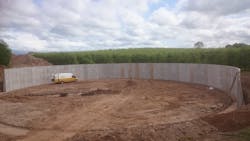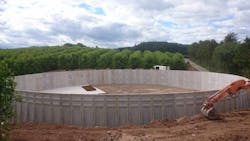About the author:
Chris French is a freelance writer on water, environment and renewable energy issues. French can be reached at [email protected].
Whites Concrete believes that precast concrete can compete and win as the design material for anaerobic digestion (AD) and biogas plant tanks.
Michael Wright of Whites Concrete said precast concrete will become part of the AD industry’s toolbox just as it has been elsewhere for more than 40 years.
Wright’s comments follow the installation of a special new elliptical tank made from precast panels for a new AD plant in Lincolnshire, England. Whites Concrete provided a circular Sealwall tank for the farm, which uses cattle manure as its main feedstock.
The elliptical tank comprises 68 precast concrete panels, while the circular sealwall tank is constructed with 30—both now providing a robust storage solution without the need for in-situ concrete, which can reduce construction time by up to 50%.
“Each precast wall unit stands includes its own base and the wall acts as a vertical cantilever,” Wright said, “with additional strength provided by the use of counterforts. The precast units used are neither pre-tensioned or post-tensioned, so there are no concerns about the tendons becoming corroded. Some previous precast concrete tank designs have been criticized because, in the event of tendon corrosion the failure mode, unlike the slow and progressive failure of a cantilever wall unit, if it ever occurred, tension failure would be sudden.”
Each unit is jointed using a tested compressible hydrophilic jointing method. Stainless steel fixings hold the precast units together, making a robust system.
The wall units are factory-cast to high quality standards and designed to exacting requirements. This ensures that the high temperature gradient stresses across the walls during winter weather, while the contents of the biogas reactor remain suitably warm to hot, are allowed for by the provision of the necessary anti-crack steel on the outer surface of the concrete units.
Similar precast concrete designs have been in use for many years in the sewage and industrial effluent treatment industry, and they have prove their longevity.
The use of precast concrete for tanks of this type is a proven technology that could be in much more widespread use for large biogas reactor tanks.
Concrete has better inherent anti-corrosion characteristics than steel. The length of life of a steel tank depends upon the longevity of the protective coatings. Once the protective layers of a steel tank are penetrated, even at small points of damage, a corrosion cell develops and the risk of leaks then occurs. Steel tank manufacturers seldom warrant the life of their products beyond 10 years, and that period often is conditional on active maintenance to identify any points of corrosion and take remedial action on any exposed metal or areas of chipped coatings. On the other hand, concrete tank designs are carried out to the buyer’s specified lifetime, and “design life” can exceed 30 years.
Concrete is a better insulator than glass-coated steel (GCS) and epoxy-coated steel. The normal practice for precast concrete reactor tank walls is to leave them exposed on the surface and readily available for inspection for the start of any leaks. This is unlike insulated GCS tanks, where the structural tank walls are hidden behind insulation materials and aluminium profiled sheeting, and unseen damage may have occurred during installation.
Concrete also can be drilled at any time to make openings that can, for example, be used to retrofit modern digester digestate mixers. The same cannot be said for steel tanks due to concerns about creating bare steel and corrosion points at any new openings.
Reinforced concrete is inherently a more sustainable material than steel for this type of construction. Steel production and transport to a site involves a substantial penalty.
Precast vs. In-Situ Cast Concrete
Casting in factory conditions permits quality standards from a highly trained specialist workforce, and economies of scale are present where a continuous production line exists for many clients. There is no need to transport the often large distances to the site.
They suffer none of the problems that can occur with concrete curing conditions for in-situ cast walls constructed out in the open in all weather conditions.
Precast construction is far more rapid than in-situ construction of concrete, saving money both on construction site staff overheads and on lead-in times for the AD plant operator.
Weighing the Costs
For biogas reactor tanks up to about 13 ft deep, it is considered by the precast concrete manufacturers that their tank would be cheaper to build. They also point out that to compare build-cost alone would not be reasonable, because a precast product that was to last even 10 years longer than an alternative steel tank would be of much greater value to the client. Many experts point out that there are examples of similar concrete structures still in use after 60 years or more of service.
For taller tanks above 13 ft in depth, glass- or epoxy-coated steel tanks (which take their loading in tension around the circumference and can be built 32 ft or more high) would naturally win on cost and constructability.
Precast can be applied to meet numerous design criteria and can be used in a wide variety of applications: walls, roofs and end-walls, to name a few. The modularity of precast means installation is faster and there is no waiting for it to gain its design strength. As with any construction, early involvement is always an advantage, but precast offers more options and will reduce the overall cost of a project.
The same precast concrete benefits apply to the design, manufacture and installation of silage clamps, utilized to store biofuel feedstock for anaerobic digesters and fermented, high-moisture stored fodder, which can be fed to cattle and sheep. The feedstock usually is made from grass crops, including maize, sorghum and other cereals, using the entire green plant.
Southeast of York in the North of England at the former Royal Air Force (RAF) Melbourne site, Northern Crop Driers recently utilized precast panels from Whites Concrete to maximize silage storage for its AD plant.
A manufacturer of dried grass horse feeds that are virtually identical to fresh grass, Northern Crop Driers needed a clamp capable of storing 6,000 tons of silage in an old hangar at the Melrose Farm base. Because roof height limited the maneuverability of machinery to compress the stored material, Whites Concrete was called upon to create a design that would use the space to full effect, keeping silage dry and clean while ensuring that load demands would meet the bulk density.
The safely stored maize, grass silage (plus some sugar beet), and slurry from sister company Melrose Pigs provides feedstock for the 500-kW AD plant.
“Investing in an AD plant made perfect sense here because it brings everything together. With our pigs and grass drying business, we knew we could generate our own green electricity, but first we had to bring in a whole year’s worth of crop, so getting our storage facility right was crucial,” said Pam Dear, from the family-owned and -run business.
Whites Concrete worked closely with Northern Crop Driers to provide two designs, including one with metalwork, but 4-meter concrete panels were ultimately chosen as the best solution.
“We were determined to utilize every inch of the hangar to give us 6,000 tons of storage, so Whites’ expertise in materials and load-bearing requirements was invaluable,” Dear said.
Over a period of one month, 150 4-meter-high Whites Concrete panels were installed at the 750-acre Melrose Farm, where grass, homegrown maize and supplies from neighboring farms combine with the pig slurry to produce enough power for everything required on site, with the excess sold on to the grid. L-shaped Groundwall panels from Whites Concrete were considered the most suitable option so as not to create any additional load bearing onto the existing structure of the old hangar. Suitable as push-walls to resist machinery loads, extreme heights of storage and areas where heavy traffic will be working, Groundwall is hygienic, quicker and more economical than block or in-situ concrete. Compliant with all relevant British Standards, no foundation is required and it is also relocatable.
“Despite being a higher cost, the precast concrete panels from Whites Concrete are actually much cheaper to install,” Dear said. “We produce high-quality horse feed from 100% natural, homegrown grass, which takes up a good chunk of power to dry out, so in the not too distant future we also hope to harness the heat from our AD plant for that part of our business. Going into AD production has given us more stability. It is helping both of our businesses grow and shows that we are serious about sustainability.”
The high quality of the digestate at Melrose Farm also is proving a winner, with its valuable nutrients producing healthier grasses. It has helped create a reduction in bought-in fertilizer.
Following the success of the silage clamp, Northern Crop Driers has since extended the storage facility by an additional 4,000 tons, installing a further 90 3-meter-high precast concrete panels from Whites Concrete to create 10,000 tons of silage space for the AD plant. These extra panels are from Whites Concrete’s Rockwall range, which achieves a finished strength in excess of 60 N for any above- or below ground construction.
“Moving into AD is a very good fit with our business model,” Dear said. “We produce 100% natural horse feeds and bedding, and now we generate our own onsite green power, with a payback of just five to six years.
About the Author
Chris French
Chris French is a freelance writer on water, environment and renewable energy issues. French can be reached at [email protected].

